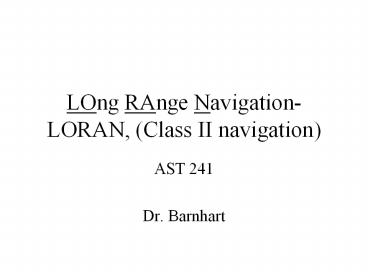LOng RAnge Navigation- LORAN, (Class II navigation) - PowerPoint PPT Presentation
Title:
LOng RAnge Navigation- LORAN, (Class II navigation)
Description:
1st Modern practical area navigation system for use in general aviation. ... known as a hyperbolic lines of position since the lines look like a parabola. ... – PowerPoint PPT presentation
Number of Views:1747
Avg rating:3.0/5.0
Title: LOng RAnge Navigation- LORAN, (Class II navigation)
1
LOng RAnge Navigation- LORAN, (Class II
navigation)
- AST 241
- Dr. Barnhart
2
LORAN Overview
- 1st Modern practical area navigation system for
use in general aviation. - Developed for maritime navigation. Early LORAN
As were exclusively for marine use - Still in use today although its use beyond 6 8
years from now is uncertain
3
LORAN Overview
- Certain LORAN-C receivers are approved for IFR
Enroute and Terminal navigation but not for
approaches. - Most LORAN-C recievers are used for VFR
navigation - For all practical purposes (for the pilot)
LORAN-C provides the same type of nav. Data to
the pilot ( ground track, desired track,
groundspeed, ETE)
4
LORAN-C Theory
- Operates in the LOW frequency electromagnetic
energy radio bandwidth which follows the
curvature of the earth therefore making it
suitable for longer ranges
5
LORAN Theory
- The LORAN-C concept is based on groups or
chains of stations around the world. - Worldwide there are 28 chains.
- Each chain consists of one master station and 4
6 secondary stations in a geographic area (ie.
Northeast U.S.chain, Great Lakes U.S. chain, etc.)
6
LORAN Theory
- The master station of each chain broadcasts a
continuous string of Low Frequency pulses
(measures in microseconds). - The unique time between the start and stop of
each pulse identifies the particular chain.
7
LORAN Theory
- This time is known as the Group Repetition
Interval or GRI. - For instance the time between the start and stop
of each pulse in the northeast U.S. chain is
99,600 microseconds or 9960 for short. 9960 is
identified as the great lakes chain
8
LORAN Theory
- The GRI is entered into the LORAN-C unit in the
aircraft upon startup along with the approximate
LAT./Long. Position during the initialization
process. This helps the unit find its position
more quickly.
9
LORAN Theory
- The LORAN-C unit then searches for that master
station and the two strongest secondary signals. - The master station pulse triggers a response from
the secondary stations. The receiver corrects for
any time lag in pulse reply.
10
LORAN Theory
- The receiver then calculates the time it takes
these signals to reach the aircraft and
essentially generates hyperbolic Lines of
Position (LOP) from each station- known as a
hyperbolic lines of position since the lines look
like a parabola.
11
LORAN Theory
- Two intersecting hyperbolas produce two possible
points for the aircraft position. - Using a second slave (or secondary) station the
receiver then pinpoints its position. Entering
the Lat./long. During initialization also aids in
this process.
12
LORAN Limitations
- Area of coverage limited to chains which dont
give global coverage - The sky wave component of the signal bounces
off the ionosphere causing navigational errors
when traveling greater than 1,000 NM from the
farthest master or secondary station- causes
errors in position of up to three miles (greater
in some cases).
13
LORAN Limitations- sky waves
- 1,000 miles is significant as at ranges less than
this, the ground wave is significantly greater in
strength than the sky waves therefore the
receiver is programmed to reject the weaker sky
waves.
14
LORAN Limitations- sky waves
- At distances of between 1,000 and 1,400 NM the
ground and sky waves are approximately the same
strength making the signals seem the same to the
receiver. - Since the sky waves take longer to reach the
receiver than the ground waves, this leads to
position errors.
15
LORAN Limitations- sky waves
- Manufacturers deal with in one of two ways
- Programming the receivers to reject all sky waves
thereby reducing the effective range of the unit
(but maximizing the accuracy) - Informing the user that nav. Data may be
inaccurate between 1,000 and 1,400 NM - At ranges greater than 1,400 NM, the receivers
can be programmed to use the sky wave
16
LORAN Limitations
- As the aircraft moves through precipitation, it
generates static electricity which generates
electromagnetic noise around the aircraft
thereby interfering with the LORAN signal-
causing the Signal Strength to Noise ratio (SNR
ratio) to go to unacceptable limits. - SNR ratio is a function of precip. Intensity and
distance from the stations.
17
LORAN- Accuracy
- LORAN accuracy is also best over water during the
day. - Conversely it is least accurate over land masses
at night (sky waves more intense at night).
18
LORAN Accuracy
- Repeatable Accuracy- ability to return to a
pre-set position for LORAN-C is .01 NM or 60ft. - Absolute Accuracy- ability of the receiver to
determine its position independently is generally
within at least 3 NM for distances up to 2,800 NM.































